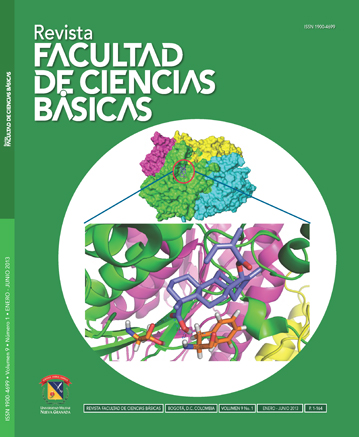Morphological Tuber Characteristics in Genotypes of Solanum Phureja Juz et Buk and ats Relationship with Powdery Scab Incidence
Abstract
This research was carried out to determine the correlation between the morphological characteristics of Solanum phureja genotypes from germplasm collection of the National University of Colombia and its response to the symptoms of powdery scab on tubers. 93 genotypes were evaluated, ten tubers for each genotype were harvested from La Union (Ant). Both, density and lenticels area, periderm thickness, color skin and shape of the tubers was determined. The data obtained were compared with the information about incidence of powdery scab on tubers under field conditions. We found a wide genetic variability in the collection evaluated for all the morphological characteristics of tubers. Black skin tubers showed the highest density and lenticels area and the lowest periderm thickness, while genotypes with red skin tuber had lowest densities and lenticels area, and intermediate values for the periderm thickness. Furthermore, long tubers had the highest density of lenticels and lowest periderm thickness, while ovoid tubers had the opposite tendency. Spherical tubers showed low density of lenticels and periderm thickness. No relationship between morphological characteristics and the incidence of powdery scab on field was found.
Downloads
References
Aist J., Williams P. 1971. The cytology and kinetics of cabbage root hair penetration by Plasmodiophora brasiccae. Canadian Journal of Botany 49: 2023-2034.
Bhattacharya S., Ray S., Dwivedi R. 1985. Sources of resistance to powdery scab in potatoes. Indian Phytopathology 38: 174–175.
Brierley J., Less A. 2008. Powdery scab-Strains and conducive conditions. Research review. Agriculture & Horticulture Development Board (AHDB). Potato Council Ltd., Oxford, UK, 43p.
Burrows M., Zitter T. 2005. Problemas de virus en papa. USDA-ARS and Department of Plant Pathology Cornell University, Ithaca, NY, 7p.
Christ B., Weidner R. 1988. Incidence and Severity of Powdery Scab on Potatoes in Pennsylvania. American Potato Journal 65: 583-588.
Claxton U., Potter J., Blakesley D., Clarkson. M. 1996. An ultrastructural study of the interaction between Spongospora subterranea f. sp. nasturtii and watercress roots. Mycological Research 100:1431-1439.
Cotes J.M., González E.P., Zuluaga C.M., Morales J.G., Marín M.A., Ñustez C.E. 2012. Informe final de proyecto de investigación “Evaluación fenotípica y genotípica de la colección de Solanum phureja por su resistencia a Spongospora subterranea f. sp. subterranea”. Universidad Nacional de Colombia y Politécnico Colombiano
Jaime Isaza Cadavid, Medellín, Colombia, 94p.
De Boer R, 2000. Summary of the session on recognizing the components of an integrated control approach to powdery scab and the potato mop top virus. p 101–104. En: Merz U., Lees A.K. (eds). The 1st European Powdery Scab Workshop, 2000. Aberdeen, UK. 102p.
Diriwachter G., Parbery D. 1991. Infection of potato by Spongospora subterranea. Mycological Research 95: 762- 764.
Falloon R. 2008. Control of powdery scab of potato; towards integrated disease management. American Journal of Potato Research 85: 253–260.
Falloon R., Genet R. Wallace, A. Braam, W. 2005. Resistance to Powdery Scab (Spongospora subterranea) in Potatoes. A Key Component of Integrated Disease Management. Acta Horticulturae 670: 57–62.
Harrison J., Searle R., Williams N. 1997. Powdery scab disease of potato. A review. Plant Pathology 46: 1-25.
Hoyos L., Villegas M., González E. 2009. Observaciones histológicas de estructuras celulares asociadas a Spongospora subterránea f. sp. subterranea en papa. Revista Facultad Nacional de Agronomía, Medellín 62: 5039-5045.
Iftikhar S., Rattu A., Asad S., Burney K. 2007. Susceptibility of potato cultivars to Spongospora subterranea under field conditions. Pakistan Journal of Botany 39: 1329-1333.
James R., Crowe F. 1995. Cultural and chemical treatments to reduce powdery scab infection on potatoes. Annual Report 987. Central Oregon Agricultural Research Center, Oregon, USA, p. 53 - 57.
Johnson S. 2002. Powdery Scab of Potatoes. Extension crops Specialist Bulletin #2436. The University of Maine, Orono (MN), USA, 3p.
Lahert J., Kavanagh A. 1985. The fine structure of the cystosorus of Spongospora subterranea, the cause of powdery scab of potato. Canadian Journal of Botany 63: 2278-2282.
Merz U. 1997. Microscopical observation of the primary zoospore of Spongospora subterránea f. sp. subterranea. Plant Pathology 46: 670-674.
Merz. U., Falloon R. 2009. Review: powdery scab of potato - increased knowledge of pathogen biology and disease epidemiology for effective disease management. Potato Research 52: 17–37.
Miller J. 2001. Powdery scab. Workshop-Summary notes. Alamosa, USA. http://www.uiweb.uidaho.edu/ag/plantdisease/scabnote.htm. Consulta en enero de 2013.
Mohan S.K., Davis J.R., Hafez S.L. 1991. Powdery Scab of Potato. Proceedings of the University of Idaho Winter Commodity Schools 23: 242-244.
Montero-Astúa M., Rivera C. 2005. Biología e importancia económica de Spongospora subterránea f. sp. subterranea, agente causal de la sarna polvorienta o roña de la papa. Manejo Integrado de Plagas y Agroecología 74: 77-84.
Nitzan N., Cummings T., Johnson D., Miller J.S., Batchelor D.L., Olsen C., Quick R.A., Brown C.R. 2008. Resistance to root galling caused by the powdery scab pathogen Spongospora subterránea in potato. Plant Disease 92: 1643-1649.
Prentice M., Clayton R., Peters J., Wale S. 2007. Spongospora subterranea (Wall.) Lagerh en tubérculos de papa (Solanum tuberosum L.) utilizando papa semilla enferma
con 10% de incidencia. Tesis de grado, Licenciatura en Agronomía, Instituto de Producción y Sanidad Vegetal, Universidad Austral de Chile, Valdivia-Chile, 85p.
Schwärzel R. 2002. Sensibilité des racines et tubercules des variétés de pommes de terreà la galepoudreuse et quelques résultats de lutte chimique. Revue Suisse Agricole 34: 261–266.
Tyner D., Hocart M., Lennard J., Graham D. 1997. Periderm and lenticel characterization in relation to potato cultivar, soil moisture and tuber maturity. Potato research 40: 181 – 190.
Van de Graaf P., Lees A., Wale S., Duncan J. 2005. Effect of soil inoculum level and environmental factors on potato powdery scab caused by Spongospora subterranea. Plant
Patholology 54: 22–28.
Wale S. 2000. Summary of the session on national potato production and the powdery scab situation. En: Merz, U. and A.K. Lees (eds.). The 1st European Powdery Scab Workshop, SAC, Aberdeen, Scotland, p. 3-9.
Ward E., Adams M. 2010. Plasmodiopforida. En: The of life web project, http:/tolweb.org/ consulta: Marzo de 2013.











